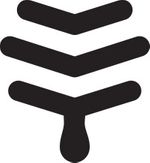Condensation inside a hive is pretty common, however, too much moisture can lead to issues such as mould and fungus and in cold weather, can chill the brood if there are excess water droplets.
Hives are prone to condensation for several reasons, mainly due to the colony’s respiration, the difference in temperature between the outside of the hive and the inside and the colony evaporating moisture from nectar to create honey.
If your hive is located in a cold and damp area, it’s important to make sure you are providing adequate ventilation for your colony.
It’s great to check with local beekeeper’s to see if they have any recommendations which might be helpful for your region.
To increase ventilation, make sure your base is set to the highest level of air-flow. For Classic hives this could be removing the corflute slider, and for Flow Hive 2 and 2+, removing the tray.
You can also cover the hole in the inner cover with some mesh to prevent bee access, then prop the roof slightly for a short time to increase the ventilation and dry out the hive. Do not leave it like this though, as it will allow water to enter the hive if it rains.
You can even consider creating a top entrance if you’re in a particularly damp area or adding a moisture blanket to your hive.
Having the indication that moisture is present in a hive is actually a benefit of beekeeping with a Flow Hive, being able to get a visual on this and act accordingly.




